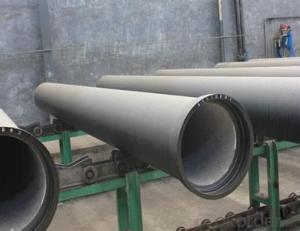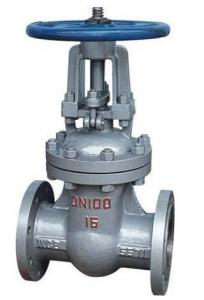DUCTILE IRON PIPES AND PIPE FITTINGS K9 CLASS DN150
- Loading Port:
- Tianjin
- Payment Terms:
- TT OR LC
- Min Order Qty:
- 22 pc
- Supply Capability:
- 3000 pc/month
OKorder Service Pledge
OKorder Financial Service
You Might Also Like
Material : Ductile Cast Iron
Size Range : DN 80mm to DN 2000mm
Unit Effective Length : 6m or 5.7m
Manufacture Standard: ISO 2531:1998/ EN 545:2006/EN 598:2007
Annual capacity : 200,000 tons
Coating Exterior: Zinc 130g/m2 according to ISO 8179-1 and bitumen coating 70 microns.
Cement Interior: Portland Cement/ High Alumina Cement/ Sulphate Resisting Cement Lining according to ISO 4179
Special requirements on external coating and internal lining can be applied
We also provide accessories such as SBR/EPDM rubber gaskets, lubricant paste, pipe caps, PE sleeves, etc.
Additional Parts:
Each pipe is strictly inspected according to related standard to ensure permanently high performance.
Easy Installation at site and service free for life
Long Service Lifespan
Quotation will arrive you within 24hours once we get your inquiry.
We guarantee offering you a competitive price.
A copy of original inspection reports of pipes will be offered after shipment.
Photos of loading process will be sent to the customer after shipment effect.
We will follow-up the delivery progress after shipment effect and update to the customer on weekly basis.
- Q:What is the expected external protection system for ductile iron pipes?
- Typically, a combination of coatings and cathodic protection is used to provide external protection for ductile iron pipes. These coatings, such as fusion-bonded epoxy (FBE) or polyethylene, are applied to the pipe's outer surface to create a barrier against corrosion and shield it from the surrounding environment. They have high resistance against moisture, chemicals, and abrasion, ensuring the longevity of the pipe. Furthermore, cathodic protection is often employed along with coatings to enhance the external protection of ductile iron pipes. This involves using sacrificial anodes or impressed current systems to generate a protective electrical current that counteracts the corrosive effects on the pipe's surface. By maintaining the ductile iron in a cathodic state, where it is less prone to degradation, this technique helps prevent corrosion. The combination of coatings and cathodic protection offers a robust and comprehensive external protection system for ductile iron pipes. These measures effectively safeguard the pipes from corrosion, resulting in extended service life and reduced need for expensive repairs or replacements. Regular inspection and maintenance are also crucial to ensure the ongoing effectiveness of the external protection system and to promptly address any potential issues.
- Q:Ductile iron pipe is how many years warranty
- In the ferrite and pearlite matrix on the distribution of a certain number of spheroidal graphite, according to the nominal diameter and the elongation of different microstructure of ferrite and pearlite in different proportions of small caliber pearlite percentage is generally not more than 20%, large diameter of the general control in about 25%.
- Q:How are ductile iron pipes protected against internal corrosion caused by chemicals?
- Ductile iron pipes are protected against internal corrosion caused by chemicals through the application of protective linings or coatings. These linings, such as cement mortar, polyethylene, or epoxy, create a barrier between the pipe and the corrosive chemicals, preventing direct contact and corrosion. Additionally, corrosion inhibitors can be added to the water or fluid being transported to further minimize the risk of internal corrosion. Regular inspection and maintenance also play a crucial role in identifying potential corrosion issues and taking appropriate preventive measures.
- Q:What are the disadvantages of using ductile iron pipes?
- One disadvantage of using ductile iron pipes is their susceptibility to corrosion. Over time, exposure to moisture and various chemicals can cause the pipes to deteriorate and develop leaks. Another disadvantage is their relatively high cost compared to other pipe materials, such as PVC or HDPE. Additionally, ductile iron pipes are heavy and require specialized equipment for installation, which can increase labor and transportation costs.
- Q:Can ductile iron pipes be used in areas with high soil salinity?
- Indeed, areas with high soil salinity can accommodate the use of ductile iron pipes. These pipes possess notable resistance to corrosion, rendering them compatible with different soil conditions, even those with elevated salinity levels. Usually, these pipes are coated with a safeguarding layer, such as polyethylene or zinc, which bolsters their capacity to ward off corrosion caused by saltwater or saline soils. Furthermore, employing appropriate installation methods, such as meticulous backfilling and soil compaction around the pipes, can effectively mitigate the potential consequences of high soil salinity on the durability and effectiveness of ductile iron pipes.
- Q:What is the expected deflection range for ductile iron pipes?
- Several factors, such as pipe diameter, wall thickness, soil conditions, and installation methods, can affect the expected deflection range for ductile iron pipes. Compared to materials like PVC or concrete pipes, ductile iron pipes generally have a higher deflection capacity. For ductile iron pipes with smaller diameters (up to 12 inches), the typical expected deflection range is around 2-3% of the pipe diameter. In other words, a 12-inch ductile iron pipe could potentially deflect by approximately 0.24-0.36 inches. On the other hand, larger diameter ductile iron pipes (greater than 12 inches) can have a slightly higher expected deflection range, ranging from 2-5% of the pipe diameter. For instance, a 24-inch ductile iron pipe could potentially deflect by approximately 0.48-1.2 inches. It is important to remember that these values are general estimates and should be confirmed with the manufacturer's specifications or engineering design guidelines specific to a particular project. Furthermore, following proper installation techniques and backfilling practices is crucial to ensure the structural integrity of the pipe and prevent excessive deflection.
- Q:What is the DN400 installation charge for ductile iron pipes?
- Labor cost: refers to the total amount of wages according to the provisions of the payment to the construction and installation works in the production of workers and ancillary production units of workers costs.
- Q:What is the expected flow capacity of ductile iron pipes?
- The expected flow capacity of ductile iron pipes can vary depending on several factors such as the diameter and wall thickness of the pipe, the type of fluid being transported, and the specific design and condition of the pipeline system. Generally, ductile iron pipes are known for their high flow capacity due to their smooth internal surface which minimizes frictional losses. They are designed to handle a wide range of fluid flows, including water, sewage, and industrial fluids. In terms of specific flow rates, it is common to refer to the Manning's equation, which is widely used to calculate the flow capacity of open channels and pipes. This equation takes into account the hydraulic radius, slope of the pipe, and Manning's roughness coefficient to determine the expected flow capacity. However, it is important to note that the actual flow capacity can also be influenced by other factors such as the presence of fittings, valves, and bends in the pipeline, as well as any potential blockages or obstructions. Therefore, it is recommended to consult the manufacturer's specifications, engineering guidelines, or work with a qualified engineer to accurately determine the expected flow capacity of ductile iron pipes for a particular application.
- Q:How are ductile iron pipes protected against external soil loads?
- Ductile iron pipes are protected against external soil loads through several methods. One of the primary methods is the use of a protective coating on the exterior surface of the pipe. This coating acts as a barrier between the iron pipe and the surrounding soil, preventing direct contact and reducing the risk of corrosion. Another method of protection is the use of trench backfill materials. The soil used for backfilling is carefully selected and compacted to provide adequate support and load distribution for the pipe. This helps to minimize the stress and pressure exerted on the pipe by the surrounding soil. Additionally, the design and installation of the pipe system play a crucial role in protecting ductile iron pipes against external soil loads. The pipes are typically laid in a properly engineered trench, which includes appropriate bedding and backfilling techniques to ensure stability and minimize the potential for damage. Furthermore, the use of proper pipe jointing techniques is essential for protecting against external soil loads. Joints are often designed to be flexible, allowing for some movement and accommodating external loads. This helps to distribute the stress along the length of the pipe and prevents concentrated pressure points that could lead to failure. Overall, a combination of protective coatings, appropriate backfill materials, proper installation techniques, and joint design contribute to the effective protection of ductile iron pipes against external soil loads. This ensures the longevity and reliability of the pipe system, even in challenging soil conditions.
- Q:How do ductile iron pipes handle traffic vibrations?
- Ductile iron pipes are known for their exceptional strength and durability, making them highly capable of handling traffic vibrations. The inherent properties of ductile iron make it more resistant to fractures or cracks caused by external forces, including vibrations induced by traffic. The material's high tensile strength and elasticity allow ductile iron pipes to absorb and dissipate the energy generated by traffic vibrations. This helps to minimize the impact on the pipes and prevent any significant damage or failure. Additionally, the ductility of the material allows it to deform slightly under stress without breaking, further enhancing its ability to withstand vibrations. Furthermore, ductile iron pipes have superior resistance to corrosion and other forms of deterioration. This resistance ensures that the pipes maintain their structural integrity over an extended period, even when subjected to repetitive vibrations caused by heavy traffic. Overall, ductile iron pipes are well-equipped to handle traffic vibrations due to their robust nature, ability to absorb energy, and resistance to corrosion. These features make them a reliable choice for underground infrastructure in areas with high traffic volumes, ensuring a long-lasting and efficient pipeline system.
1. Manufacturer Overview |
|
|---|---|
| Location | |
| Year Established | |
| Annual Output Value | |
| Main Markets | |
| Company Certifications | |
2. Manufacturer Certificates |
|
|---|---|
| a) Certification Name | |
| Range | |
| Reference | |
| Validity Period | |
3. Manufacturer Capability |
|
|---|---|
| a)Trade Capacity | |
| Nearest Port | |
| Export Percentage | |
| No.of Employees in Trade Department | |
| Language Spoken: | |
| b)Factory Information | |
| Factory Size: | |
| No. of Production Lines | |
| Contract Manufacturing | |
| Product Price Range | |
Send your message to us
DUCTILE IRON PIPES AND PIPE FITTINGS K9 CLASS DN150
- Loading Port:
- Tianjin
- Payment Terms:
- TT OR LC
- Min Order Qty:
- 22 pc
- Supply Capability:
- 3000 pc/month
OKorder Service Pledge
OKorder Financial Service
Similar products
New products
Hot products
Related keywords

























